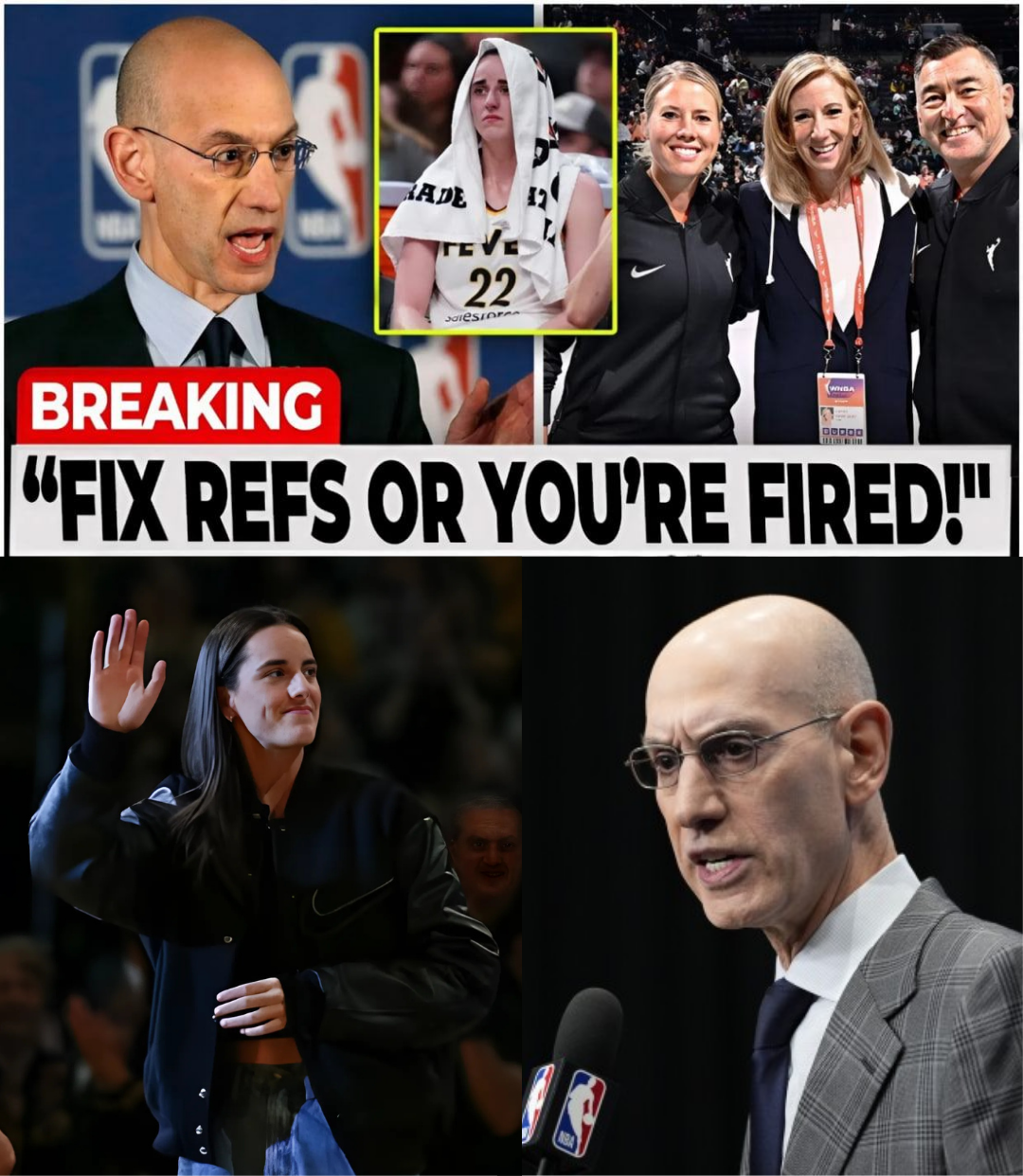
She didn’t walk off the court because she was tired.
She walked off because no one else did.
No one else blew the whistle.
No one else stepped in front of the hits.
No one else said enough — until now.
Caitlin Clark has officially withdrawn from the 2025 WNBA All-Star Game, citing “lower-body discomfort.”
But inside the Fever locker room — and across every boardroom where her name is currency — everyone knows that’s not the story.
The real story is what broke after the announcement.
A phone call.
A warning.
And the unmistakable voice of Adam Silver cutting through the silence that had been smothering the league for months.
SCENE ONE: THE HIT THAT WAS NEVER CALLED
It came like so many others.
A routine drive. A high screen. A hip-check that shifted her center of gravity just enough to collapse her sideways. Caitlin Clark hit the hardwood, her arm extending too late to brace, her left knee awkwardly twisted beneath her.
No whistle.
No pause.
No replay.
She got up slowly — this time, noticeably slower.
She didn’t complain. She never does.
But the pain was visible, even through the cameras. She reached for her leg. Then her lower back. Then sat down during the timeout with an ice wrap and a silence that said more than any sideline interview could.
That silence didn’t end when the buzzer sounded.
It carried through the press room.
Through the corridors.
Into the team bus.
And onto the phone line that would change everything.
SCENE TWO: THE ANNOUNCEMENT THAT BROKE THE PATTERN
“Caitlin Clark will not participate in the 2025 WNBA All-Star Game due to precautionary injury management.”
Just twenty words. No quotes. No details. No replacement. No photo of her waving in team gear.
But in a season where every highlight had her face, every promo her name, that absence said everything.
Within 90 minutes of the league’s tweet, NBA Commissioner Adam Silver made the most important phone call of the season.
What he said wasn’t public. But what happened next made sure the message wasn’t missed.
SCENE THREE: THE CALL THAT SHOOK THE HEADQUARTERS
Three sources close to the WNBA confirmed it: Adam Silver didn’t just call. He summoned.
He asked for an executive briefing — fast. No PR liaison. No layers of handlers.
“He wanted them raw,” one source told us.
And when the room was virtual and full?
He didn’t raise his voice. He didn’t posture.
He just said this:
“If she’s not on the floor, your business model isn’t either.”
That sentence landed like a hammer.
Then he followed it with another:
“You do not get to market her and then stay neutral when she’s hurt.”
And finally:
“This isn’t about one game. This is about whether the league can be taken seriously — by fans, by brands, by players, and by me.”
He ended the call without a thank you.
The silence afterward wasn’t shock.
It was exposure.
SCENE FOUR: THE CRACKS START TO SPREAD
Inside WNBA headquarters, staff were ordered into emergency communications meetings. Marketing leads were told to halt all pre-scheduled All-Star posts that featured Clark.
Two All-Star alternate players were put “on hold” pending final clearance — a process that usually takes days, done in less than three hours.
Referee assignments for the All-Star Game? Suddenly reshuffled. One veteran official removed from the roster entirely. No explanation.
And in the commissioner’s suite? The lights stayed on late.
One intern was overheard whispering, “Is this the moment everything changes… or falls apart?”
SCENE FIVE: THE INTERNET TURNS THE KEY
By morning, the hashtags were everywhere.
#ClarkOut
#Protect22
#SilverStepsIn
#SilentNoMore
#WNBAAccountability
TikTok accounts broke down slow-motion replays of Clark’s uncalled fouls like it was Zapruder film. YouTube creators built timelines from April to July. SportsCenter ran a full segment titled “The Cost of Not Protecting Caitlin.”
One viral tweet:
“She didn’t protest. She didn’t post. She just disappeared — and the league’s mask came off.”
Another:
“When your biggest star pulls out of your biggest game and the NBA Commissioner cares more than you — it’s not a league. It’s a liability.”
The anger was everywhere.
But so was the heartbreak.
One fan posted a selfie in a Clark All-Star jersey with the caption:
“Got this to wear Saturday. Now it just feels like a souvenir from a league that doesn’t deserve her.”
SCENE SIX: FEVER LOCKER ROOM – COLD, QUIET, UNITED
Clark hasn’t spoken publicly. Not yet.
But sources say she’s been “visibly shaken.” Not just by the injury — but by the pattern. The constant collisions, the late or missing whistles, the expectation to “take it” because she’s young, white, popular, or all three.
One assistant coach reportedly said:
“It’s not just physical. It’s psychological warfare. Every hit tells her she doesn’t belong here — and every no-call proves it.”
Aliyah Boston didn’t do a press conference.
She didn’t tweet.
She just posted a black square with the caption:
🕰️
Kelsey Mitchell, after morning shootaround:
“People say she sat out. Nah. She finally stood up. And I hope the league hears it.”
SCENE SEVEN: THE BUSINESS REACTION – WHEN BRANDS NOTICE
This wasn’t just an injury.
It was a market crisis.
Within 48 hours, a major sports apparel brand — rumored to be Nike — paused a $2M ad buy planned for All-Star Weekend. Reason? “Creative revisions following player availability changes.”
Translation: If Caitlin’s not there, we’re not paying for it.
Two corporate sponsors contacted the league demanding clarity on “player treatment standards” and “future investment guarantees.”
A third, tied to a beverage campaign using Clark’s image, requested immediate digital blackout “until further notice.”
By Friday, internal memos from the WNBA’s media department revealed a planned “emergency narrative shift” focused on “rising stars and league-wide growth.”
But the draft post failed to include Caitlin’s name even once.
It didn’t make it past review.
SCENE EIGHT: THE IMAGE THAT SAID TOO MUCH
Friday morning, 6:47am.
A blurry photo surfaced on Reddit.
Clark — alone — at a private gym in Indianapolis.
Black hoodie. Knee brace. One hand on a medicine ball.
The other holding her phone.
No smile.
No team gear.
No caption.
The post exploded.
Comments ranged from rage to reverence:
“They broke her body and made her feel like she had to hide the healing.”
“This isn’t a protest. This is an exodus.”
“If this doesn’t wake up the league, nothing will.”
But it wasn’t the photo that broke Twitter.
It was the follow-up post.
From a Fever trainer.
Quiet. Simple.
“She’s playing the long game. And the league just realized she’s the only one who knows the rules.”
SCENE NINE: INSIDE THE LEAGUE — THE DAY THE SPIN STOPPED WORKING
By midday Friday, the WNBA had drafted four official statements.
One focused on “athlete recovery.”
Another on “the evolution of league officiating standards.”
A third tried to spotlight other All-Star names.
The fourth?
Never saw the light of day.
It began with the words:
“We hear you.”
And ended with the sentence:
“We promise to do better.”
It was killed by legal before noon.
Instead, the WNBA released a 47-word paragraph buried under an All-Star promo carousel. It didn’t mention Clark. It didn’t mention Adam Silver. It didn’t mention anything at all.
But that wasn’t the silence that mattered most.
The silence that counted came from inside the room.
One staffer told us:
“You could feel it. The air changed. It wasn’t just a PR crisis. It was reputational collapse.”
Another?
“People were asking themselves the one question no league ever wants to face:
What if she doesn’t come back?”
SCENE TEN: WHAT ADAM SILVER REALLY MEANT
Sources say Silver has not returned follow-up calls from WNBA leadership.
But he doesn’t need to.
Because in every boardroom from ESPN to Gatorade to Nike, that one line he dropped has already been framed:
“You do not get to market her and then stay neutral when she’s hurt.”
It wasn’t just a scolding.
It was a contractual bomb.
Silver wasn’t just defending a player.
He was reminding the WNBA that Clark is their entire pitch deck.
Their Q3.
Their future TV deal.
Their cultural relevance.
And by not protecting her, they’ve jeopardized all of it.
That’s why, for once, his silence after the call was even louder than the words during it.
SCENE ELEVEN: CAITLIN CLARK — THE PROTEST WITHOUT A PRESS CONFERENCE
No statement.
No appearance at All-Star events.
No friendly sit-down on ESPN.
Just one action:
Absence.
And in that absence, the most damning message of the season:
“I won’t scream. I won’t beg. But I won’t show up for your applause while you ignore my bruises.”
It’s protest without posture.
Power without speech.
Leadership without permission.
And it’s working.
Because the very system that tried to quiet her rise…
Now can’t breathe without her.
SCENE TWELVE: THE COACHES WHISPER, THE PLAYERS GATHER
Behind closed doors in Vegas — where All-Star events are moving forward without their top star — several players reportedly met in an unofficial huddle.
Topic?
“How much more are we supposed to take?”
One All-Star said, “We’re all watching what they do next. Because if Caitlin can’t be protected, none of us can.”
Another:
“We know we’re in a league that wants our likeness, not our longevity.”
Even some coaches have spoken — off-record — about how the league’s officiating has turned into “narrative management.”
One coach:
“They wanted her fire, but not her fight. And now they lost both.”
SCENE THIRTEEN: THE SPONSORS DON’T FORGET
A major beverage company — previously leading WNBA marketing efforts — leaked an internal memo:
“As of this week, our exposure plan must adjust to minimize volatility associated with All-Star programming. Priority shift: move assets to college-level campaigns.”
Translation:
If Caitlin Clark isn’t visible and safe in the pros, they’ll invest where she used to be: Iowa.
Another brand quietly withdrew from on-site activations, citing “audience unpredictability.”
And one exec summed it up like this:
“You can’t sell empowerment and then vanish when the empowered woman gets hurt.”
SCENE FOURTEEN: THE FINAL IMAGE
Late Friday night, local reporters caught a glimpse of Clark leaving the Fever facility.
She wasn’t limping.
But she wasn’t smiling either.
She nodded to a staffer.
Tossed her bag into the trunk.
Paused.
Then looked straight ahead at the reporters — and didn’t blink.
No interview.
No wave.
Just that look.
One reporter said:
“It was like she was daring us to speak first — to decide what kind of story this would be.”
EPILOGUE: WHEN THE COMMISSIONER CALLS, IT’S ALREADY TOO LATE
This isn’t about missing one game.
It’s about everything that led to that moment.
The contact.
The no-calls.
The silence.
The weight.
And the question echoing now from ESPN studios to boardrooms to the league itself:
“How did we let it get to this?”
Because when the league’s most valuable player disappears from its biggest stage, and the most powerful man in basketball is the one who has to speak up—
It’s not just an injury.
It’s a reckoning.
And what Adam Silver said may have been simple.
But what he meant?
Was final.
“She’s already hurt.
You don’t get to do it twice.”






